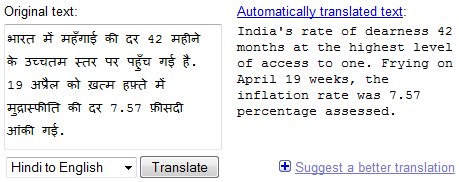
That is why many Universities of the West have acknowledged the existence of two or more languages and, therefore, have introduced Translation Studies in their Universities. We may include such countries as India, Canada, U.S.A.

The value and volume of translation increases in countries where residents are multilingual and multicultural. A good translation creates in his reader the impression that he is reading not a translated work but an authored one. A careless translator may bring about in his task losses in meaning, feeling and effect. The success of a translator depends on his approach to his method for a literary translation can be made useful only when the doer knows that one cannot succeed if one tries to make a literal equation of word for word, phrase for phase, or even simple equation of sentences or images for it does not produce good translation because two languages have different grammar, different idioms and different structural patterns. Many Indian poets have shown that they were not translating but actually producing their own work. The art of translation also rendered a large number of Indian material into English in such a way that English knowing Indian readers have found a lot to entertain and educate them. His political relation with England, which was becoming more and more hostile every day, did not alter the situation. This co-existence of English and Indian literature became a feature of intellectual life of the English educated Indian. …the modern Indian literary history provides a singular case of co-existence of two literatures, one of them alien, English and the other indigenous, an Indian literature. Indian poets were influenced by the British literary movements so much so that they wrote poetry manifesting the manifest impact of British movements : Indian students enjoyed the beauty of Sanskrit literature and Greek and Roman poets like Homer and Virgil through translation.

There is a lot of truth in the following words of Sisir Kumar Das : “The contact with English literature provided the Indian author and the reader with a new set of values and canons, thus creating an area of commonality of perception in the endless variety of different Indian literatures”. Who would have heard the name of Rabindranath Tagore but for his own translation of his immortal Gitanjali ? No British reader would have bothered to learn Bengali so that he might have enjoyed the Indian poet. Had it not been translation, many Indian authors would have remained unknown outside the Indian frontiers. Modern Indian literatures were dominated by the influence of the literary activity of the rulers.Ī study of Indian literatures during the late nineteenth and twentieth century reveals that the art and technique of translation was very largely responsible for its growth. The flow of interaction between English and Indian literatures had its impact and response on the literary activity of the latter which was deeply influenced by Romanticists and neo-classicists, the followers of art for art’s sake and art for morality, Puritanism and imagism or symbolism. Choudhuri’s remark, “On the literary side, in addition to the names of Shakespeare and Milton …, we came to know of Homer as soon as we began to read the Ramayana and the Mahabharata, which was fairly early.” (Choudhuri 101) Such beginnings initiated writers and readers to European literatures.

There is a lot to understand the value of translated literatures in Nirad C. It went a long way in increasing the treasure of English and vernacular literatures. It was also a result of the writers’ interest in translating various Western literatures into English as well as English books in Indian languages. Though this trait was visible in the Victorian age as well, the number of readership grew in India as English had taken roots in Indian universities also. But it did not hamper the growth and quality of literature in Indian languages. The previous century witnessed the rise of literature in English in India. The Role of Translation in Indian Writing in English


 0 kommentar(er)
0 kommentar(er)
